1lumen selects and reviews products personally. We may earn affiliate commissions through our links, which help support our testing.
Lumintop PK21 review: thrower flashlight (proto type)
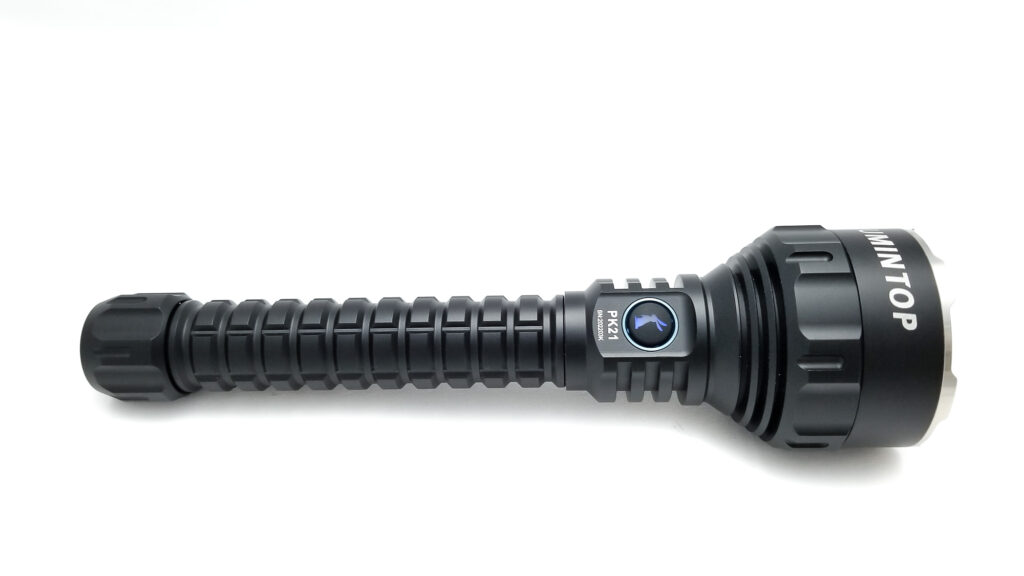
Lumintop PK21 specifications
| Brand & Model | Lumintop PK21 |
|---|---|
| LED | CREE XHP70.3 HI |
| Lumens | 8,100 Lumens |
| Beam intensity | ? |
| Battery config. | 2*21700 |
| Onboard charging | None |
| Modes | Many, runs Anduril |
| Blinkies | Many |
| Reflector | OP |
| Waterproof | IPX8 |
| Review publication date | August 2022 |
Introduction:
Note: this is a prototype product
In the flashlight continuum, there are few brands that have arisen to the position that Lumintop occupies (or has a bunny as their logo), and for good reason. They have stores on the big e-commerce merchant sites including their own, so you can get a Lumintop light very easily anywhere in the world. Operating as the Lumintop Technology Company, they’ve been a major contributor to the flashlight scene, delivering products that appeal to enthusiasts and regular consumers at affordable prices.
Moreover, most folks who have been in this hobby for any amount of time immediately recognize Lumintop as the minds behind the BLF GT and GT94 (the only challenger to the Wuben A1, mind you), and the prolific FW series. Well, Lumintop is at it again, releasing some exciting new lights of late, one being the PK21. This is the larger version (very much so) of the current 2AA PK27. The PK21 is a long-range, high output flashlight. How high output? How does 1200 meters of throw and 8100 Lumens out of a single LED sound? These are mighty impressive specs, and Lumintop gave the PK21 an equally impressive UI to go with it. This light hasn’t gone on sale yet, and one of the benefits of being a flashlight reviewer is I get to put it to the test. Let’s see!
Package quality.
Lumintop has never invested heavily in packaging accouterments or flashy graphics, and I’m not sure if being a pre-production light has any bearing on that, but the PK21 came in a very plain brown box with a flip open lid. No graphics, specs, or blurbs to be found here, just a plain box with a flashlight in it:
- Lumintop PK21
- Two Samsung 30T lithium-ion batteries (loaded in the light)
Yep, that’s it. I was really glad to see they included batteries, since you really need identical, matched sets of batteries in order to get the most out of the light. Like the Nightwatch and other pre-production samples I’ve received, the batteries were isolated by a piece of cardstock stuck between the negative pole and tailcap spring. The batteries were sitting at 3.52 volts each, an acceptable voltage for long-term storage.

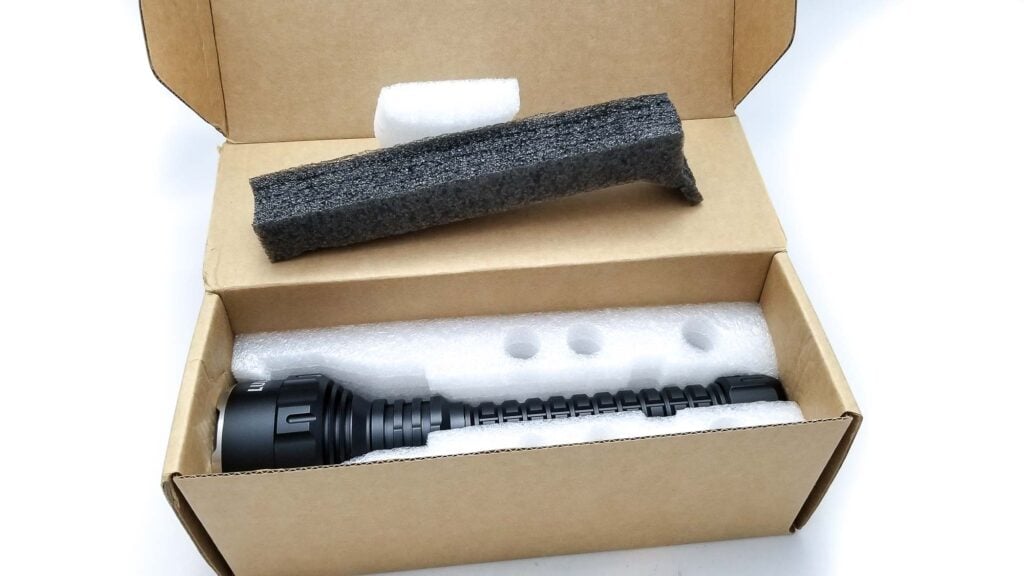
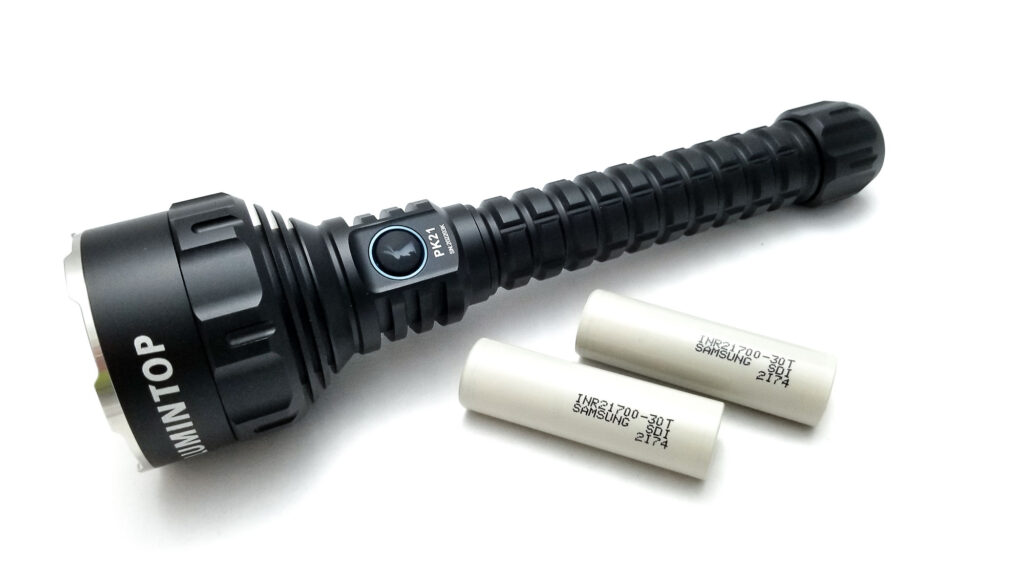
Flashlight in use
The PK21 is a long-range general purpose light, so the list of use-cases is pretty long, but generally you’d grab this for times when you need a lot more reach and output than your C8 with an XHP50.2 or your Thrunite TC20 V2 can manage. It’s too large and heavy to be an EDC piece, so the best way to tote the PK21 around is in a pants pocket or riding in a holster on your belt. There is a lanyard attachment point, but no attachment. More on that later. I really liked the handling dynamics. The light is hefty and has really good balance. The aggressive knobbles on the battery tube afforded great control and confident handling in all grip positions.
The tailcap seems to act as a counterbalance as well, and this helps with natural pointing and reduced hand fatigue. There’s a single e-switch behind the head, set in a really nice blue anodized aluminum bezel. The button is large and has LED backlights behind a translucent bunny logo. It lights up when on standby and during operation to show battery state, and thanks to the UI, you can adjust the intensity of the LEDs (or turn them off). The switch is perfectly fine, and I liked the nice feedback and feel with solid, snappy clicks. The proud boot was always easy to find in the dark as well.
The tailcap has 4 ceramic balls embedded in it for glass breaking, and there’s also a ¼-20 UNC socket for affixing a lanyard mount or other attachment. I tried the harness mount from the Fenix LR80R, and it screwed in just fine. Tail standing is possible (but wobbly), and it won’t roll away on an inclined surface.
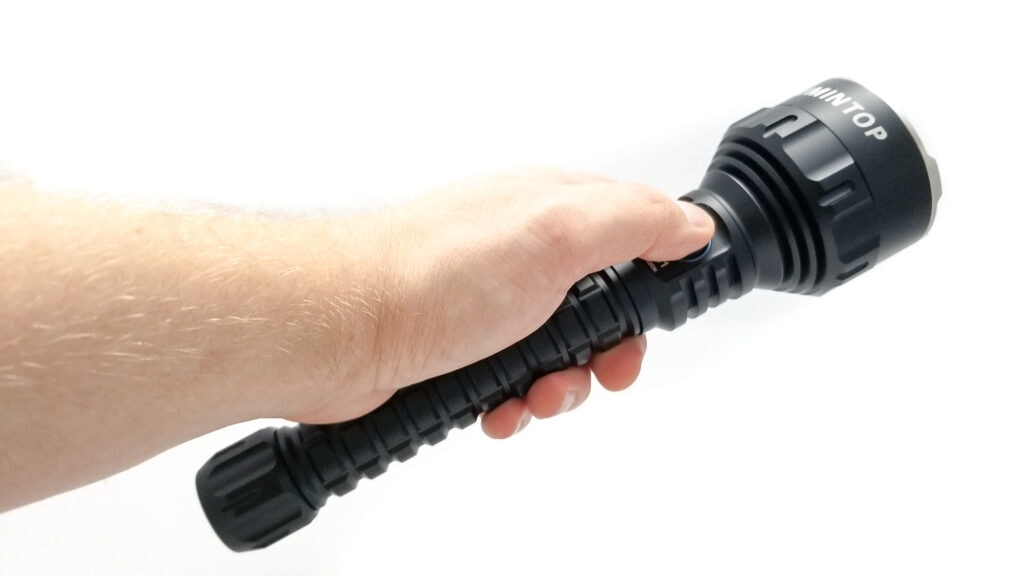
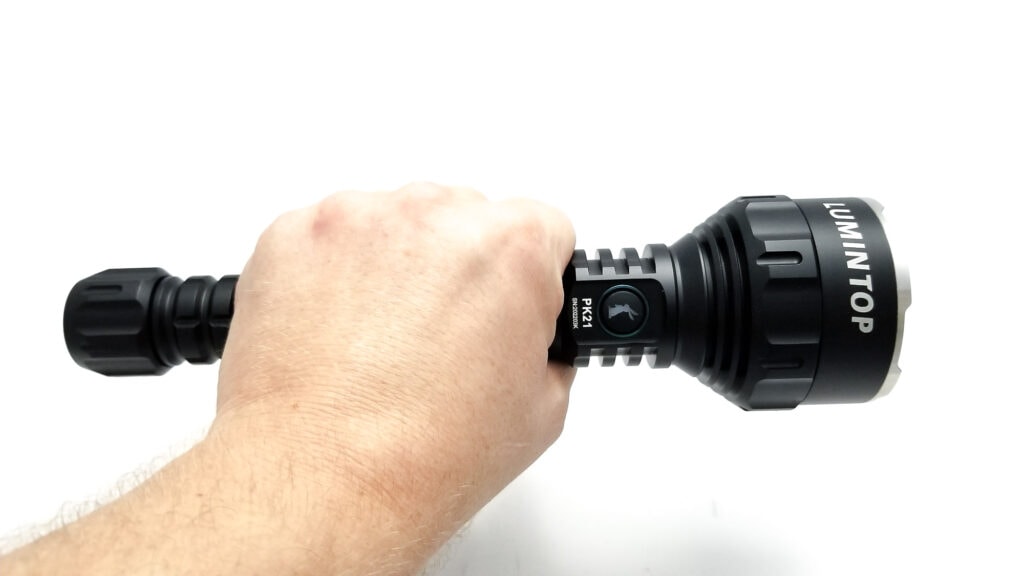
Build Quality, and Warranty
Lumintop makes great middle-of-the-road flashlights, so they’re very solid and well made lights at a good price. No MSRP is listed for the PK21 yet, but even with the expensive LED, I suspect it will be an affordable light nonetheless. The light is milled from high quality aluminum, probably 6061-T6, and the machining is meticulously done, including the stainless bezel. It’s every bit as good as Acebeam or Fenix with no chips, dings, or errant tooling marks. It’s been given the carry melt treatment as well, with no abrupt edges on this light anywhere. I really like and appreciate that attention to detail. The anodization is probably type III HA, and it’s also meticulously applied. I like the more-matte-than-glossy finish since it adds traction and it just looks nicer. The PK21 rode around in my pocket bezel-down with keys, another flashlight, and my phone without any damage to the finish. The only quality issue I ran across was the (huge) Lumintop logo on the bezel isn’t perpendicular with the switch. It’s offset about 30 degrees from the center. Annoying, albeit a minor issue.
This is one sturdily-built light. The battery tube walls are a full 2.4 mm thick, which is good for heat absorption. The threads are rectangular cut, and the rears are fully anodized and well lubed with excellent smoothness. The fronts are even thicker and anodized for a good thermal interface and electrical connection. These threads were very smooth, also with plenty of lube. The stainless bezel is also removable without the lens falling out, and the whole light can be disassembled if you want. The bezel unscrews by hand to reveal the MCPCB and reflector. The rear switch PCB and driver are held in with brass retaining rings. The rings are really tight, and I gave up trying to dislodge them, but I’m sure they aren’t glued. There’s a centering screw in the head that interfaces with the front ridge of the reflector for indexing. Nice. The soldering for the LED wires is nice and tidy with very little flux and there’s plenty of gray thermal paste under the copper DTP MCPCB. The springs on the driver contact and tail switch are pretty thick, non magnetic gold plated copper alloy for a low resistance current path.
Warranty? From Lumintop.com: 30-day free replacement: LUMINTOP will replace a new product within 30 days of purchase for any manufacturing defects if problems come into being in normal use; We will replace it with the same model. If the model has been discontinued, customers will receive a product with a similar or improved model. Five-years free repairs: LUMINTOP will offer free repair within 60 months for lights from the date of purchase if the problem develops with normal use. Lifetime warranty: If repair is required after guaranty period, we’ll charge for parts accordingly. All LUMINTOP products are warranted for quality. Normal wear and tear are not covered, nor is damage resulting from misuse, abuse, neglect, battery damage, use of incorrect batteries or accessories, or altering these products from their original state. Parts and accessories for flashlights are not covered by this warranty.
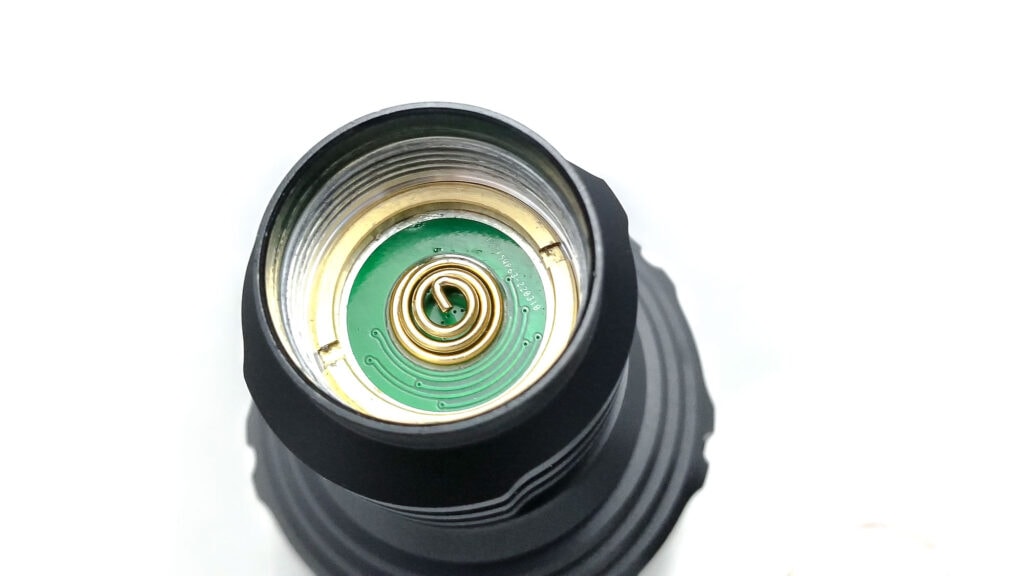
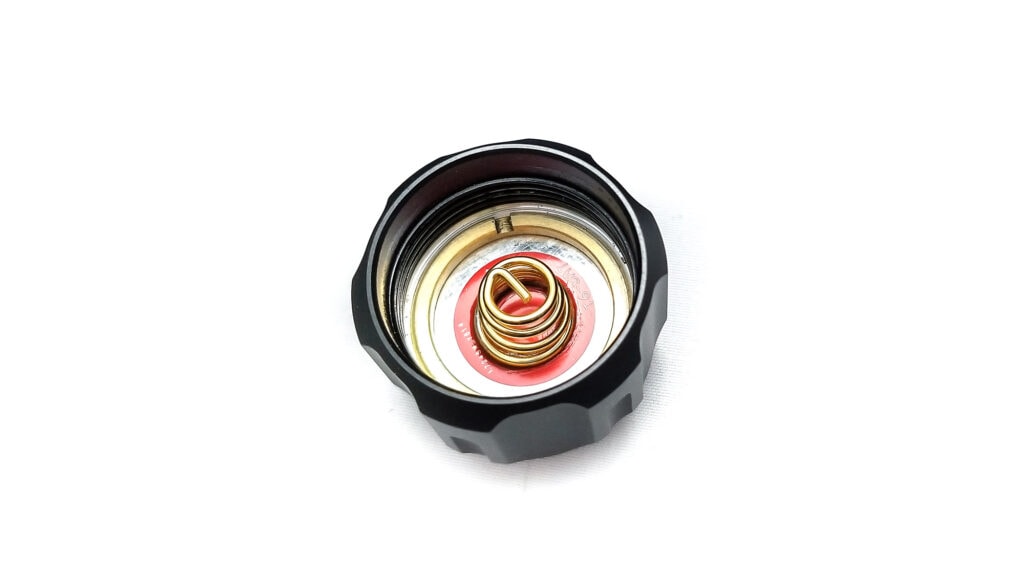
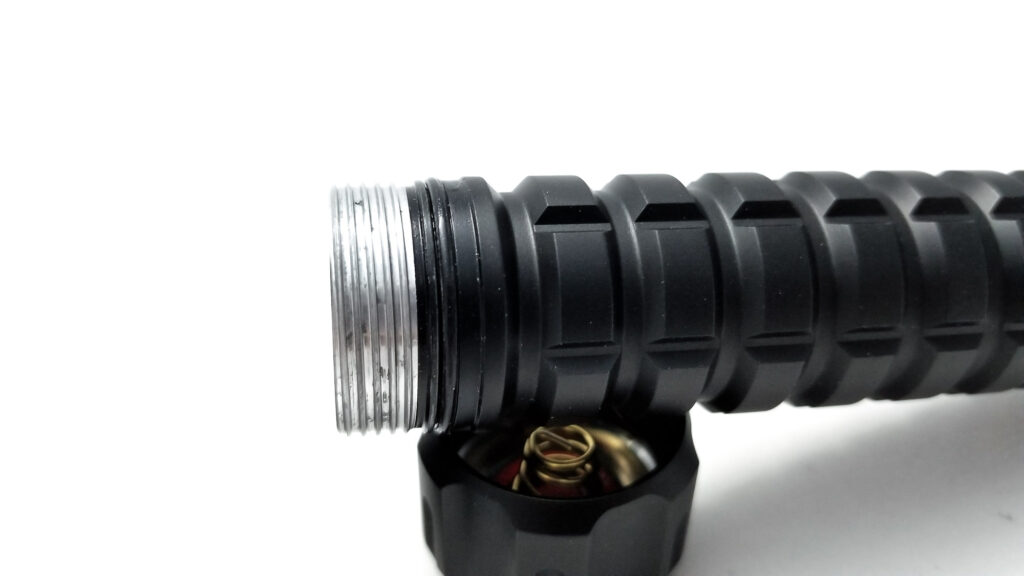
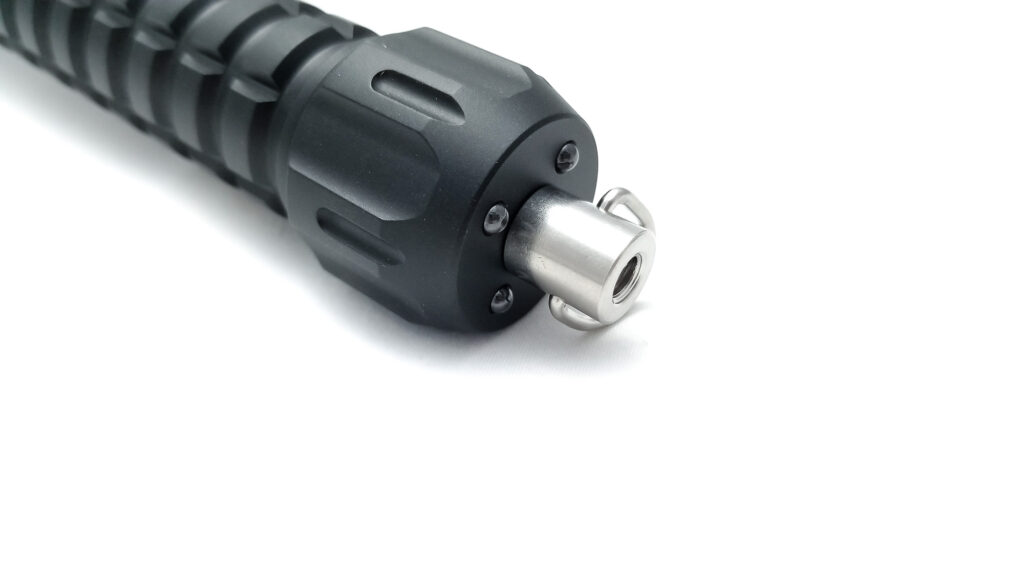
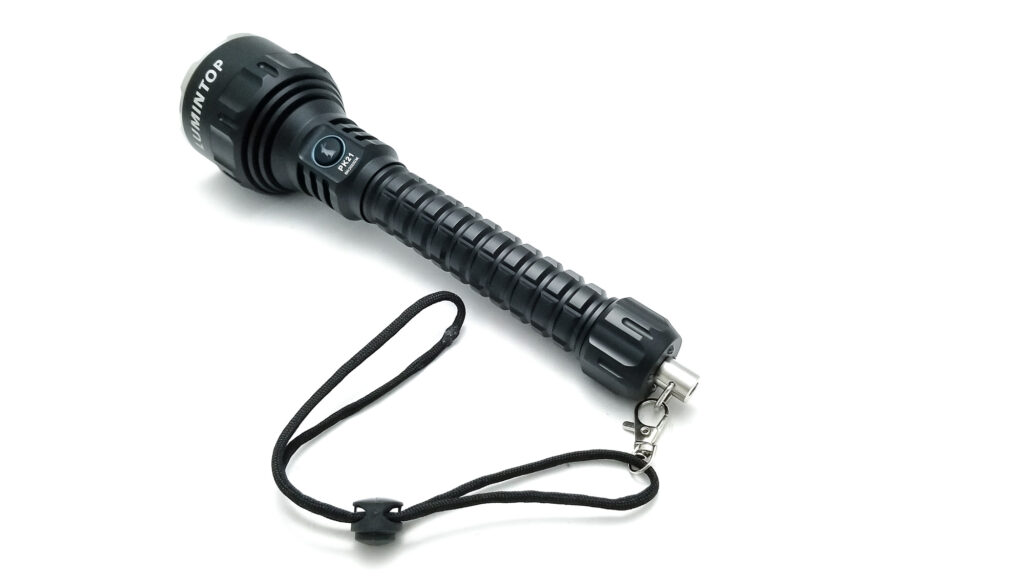
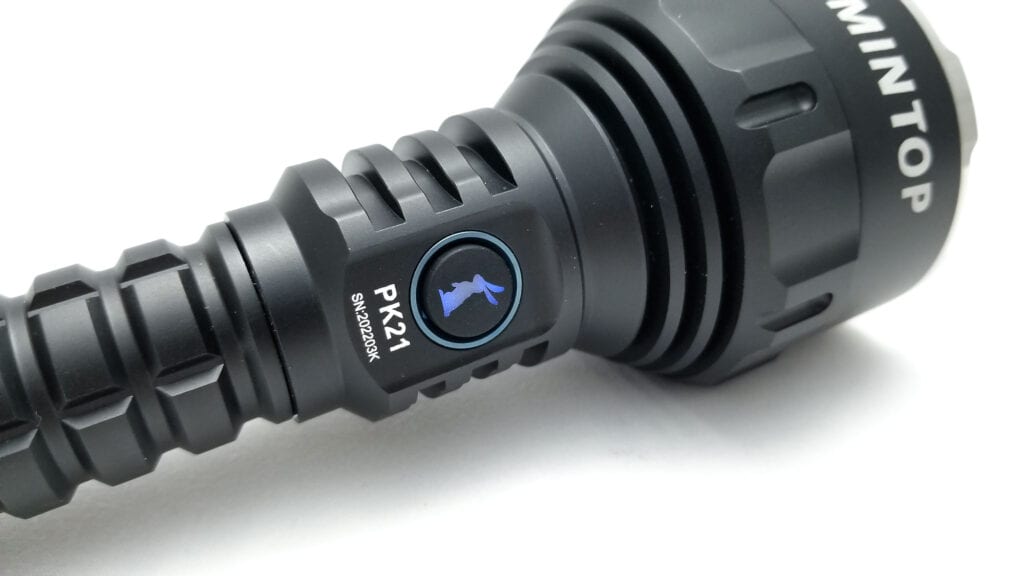
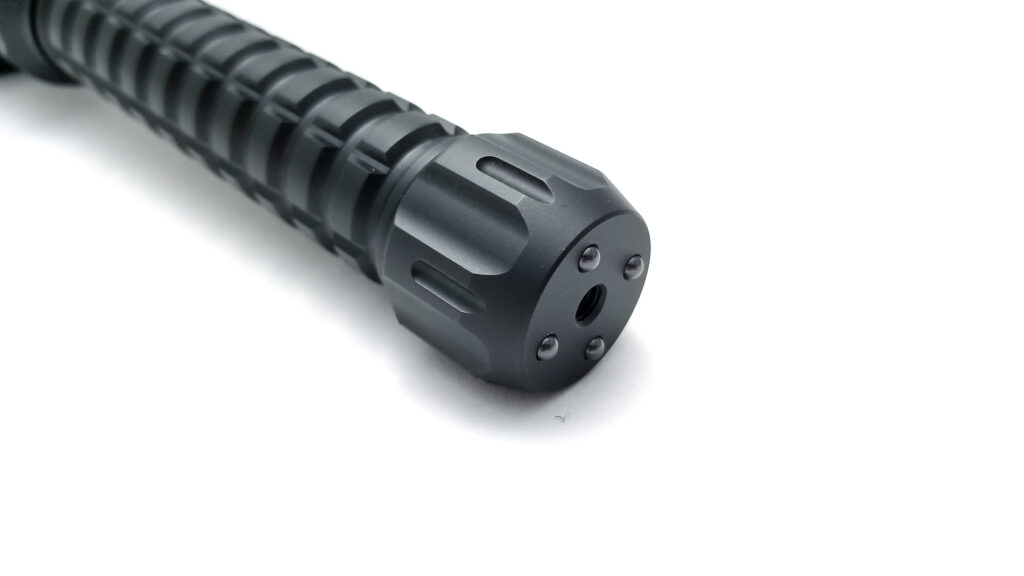
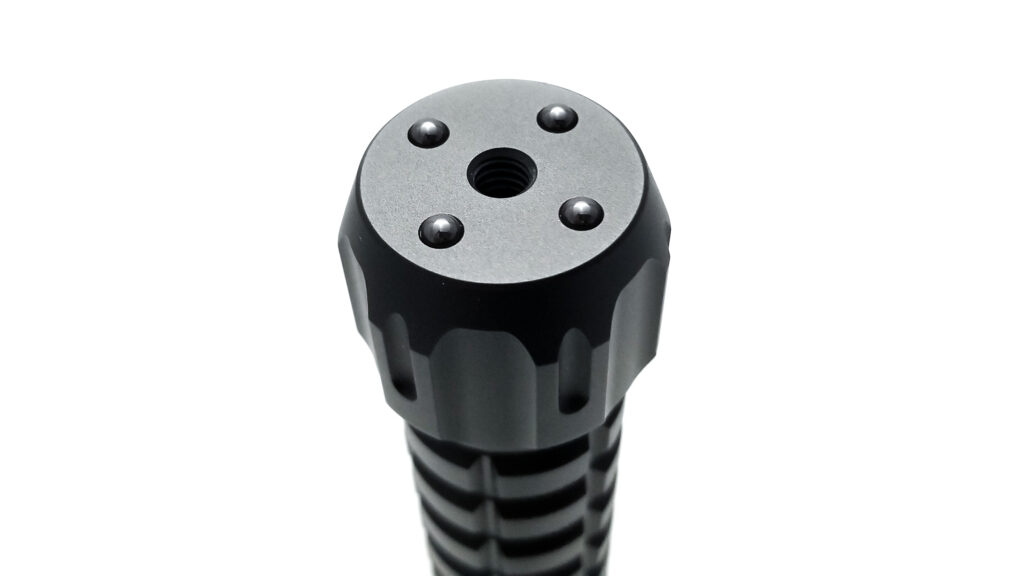
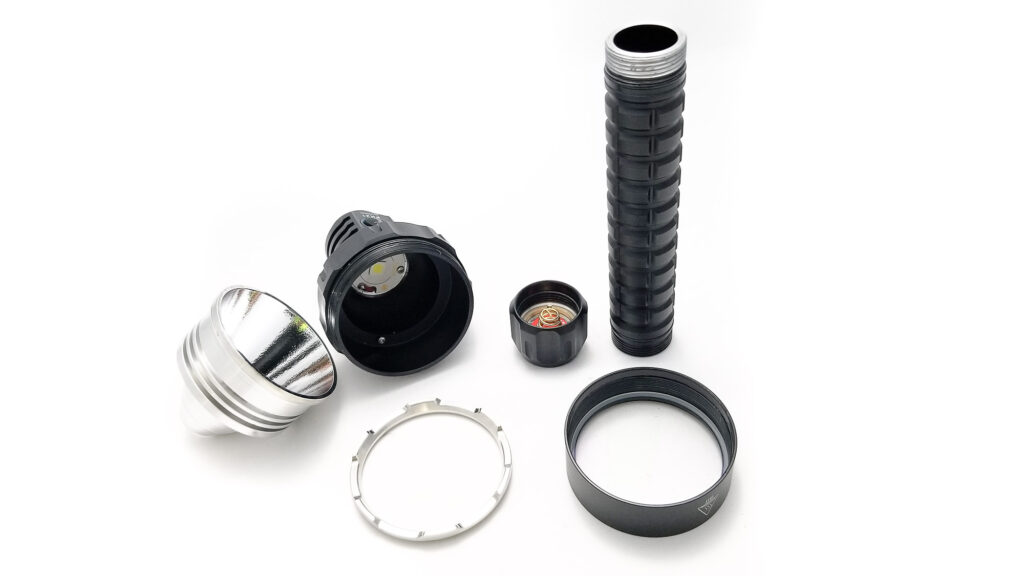
LED, Lens, Bezel, Beam, and Reflector
The LED is none other than the Cree XHP70.3 HI. Yep, this is the LED that enthusiasts have been asking Cree for ever since the 70.2 came on the scene in 2018, and anyone who’s ever sliced and diced a 70.2 will appreciate Cree’s effort to bring one to market. This LED is available in the HD (high density domed) and HI, (high intensity domeless). In case you’re wondering, why lose the dome? It gives an overall cleaner beam with less angular tint shift and a more evenly-tinted spill and hotspot. It also improves the cd/mm2 over the domed version, albeit at a lower luminous flux output. It runs on 6 or 12 volts (depending on the MCPCB), and the 70.3 HI adds some meaningful efficiency upgrades by means of a lower thermal resistance of 0.2 C/W.
No tint is specified, but it’s of course going to be cool white. The Opple Lightmaster Pro is showing the LED coming in around 6712K on L4 up to 8097K on L7, so we have some tint drift. The CRI (Ra) for L7 is 72.5 and duv is coming at -0.0036. The reflector is a 55 mm diameter deep OP unit.
The LED is perfectly centered with a plastic centering ring, and the lens has a purple dual-AR coating on the toughened mineral glass lens. The bezel is a nicely-machined and crenulated stainless unit that can be removed. The beam is very nice, the hotspot is very diffused and blends into the spill. There are some artifacts in the beam, and they are noticeable, but manageable and you won’t care once you click into Turbo! It has plenty of reach as well for a big LED.
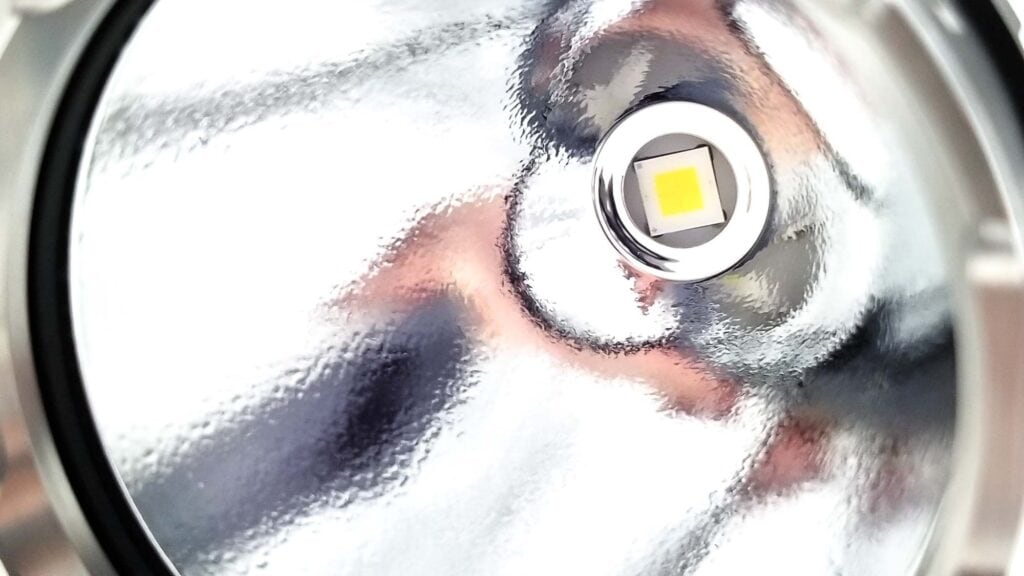
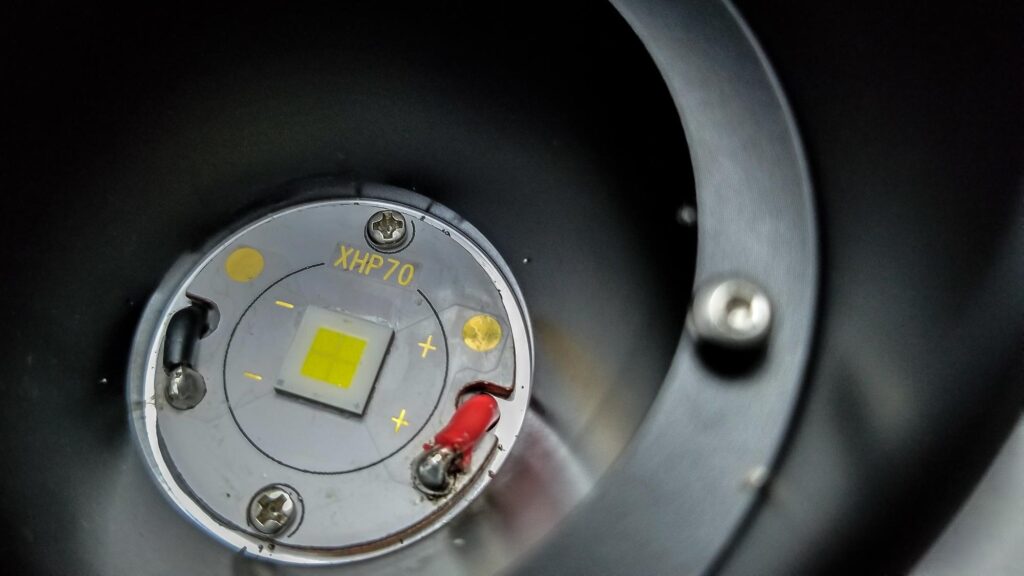
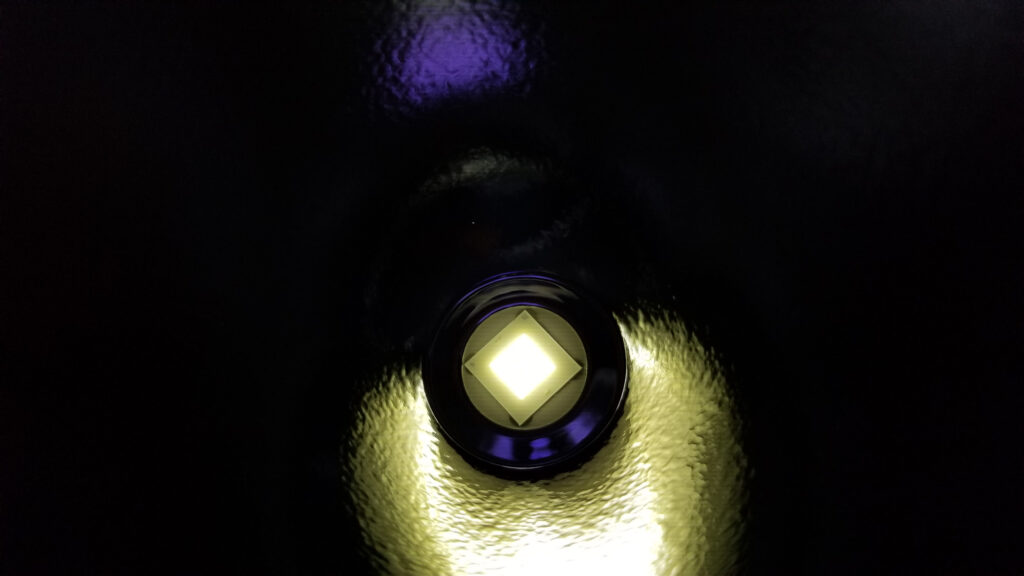
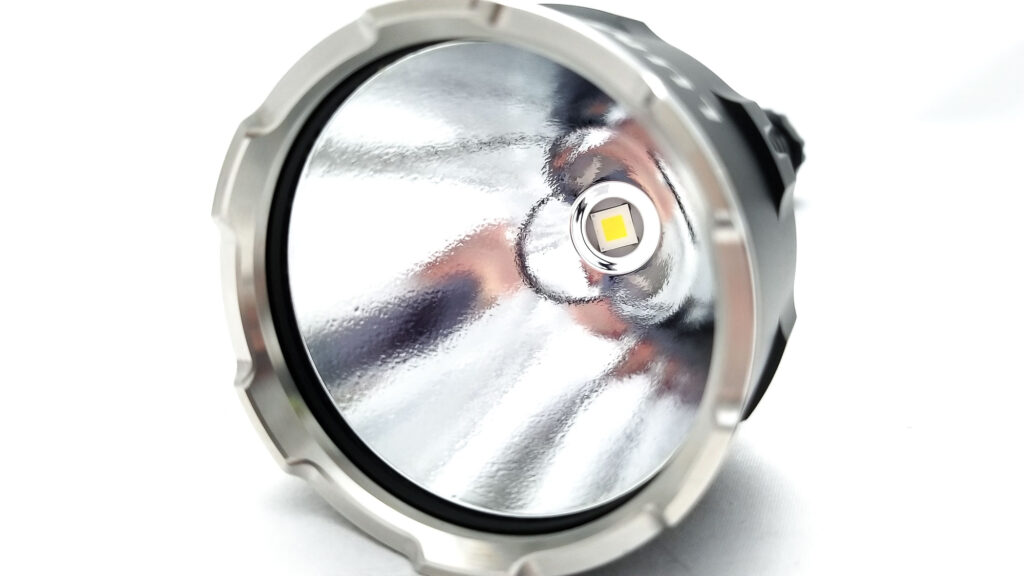
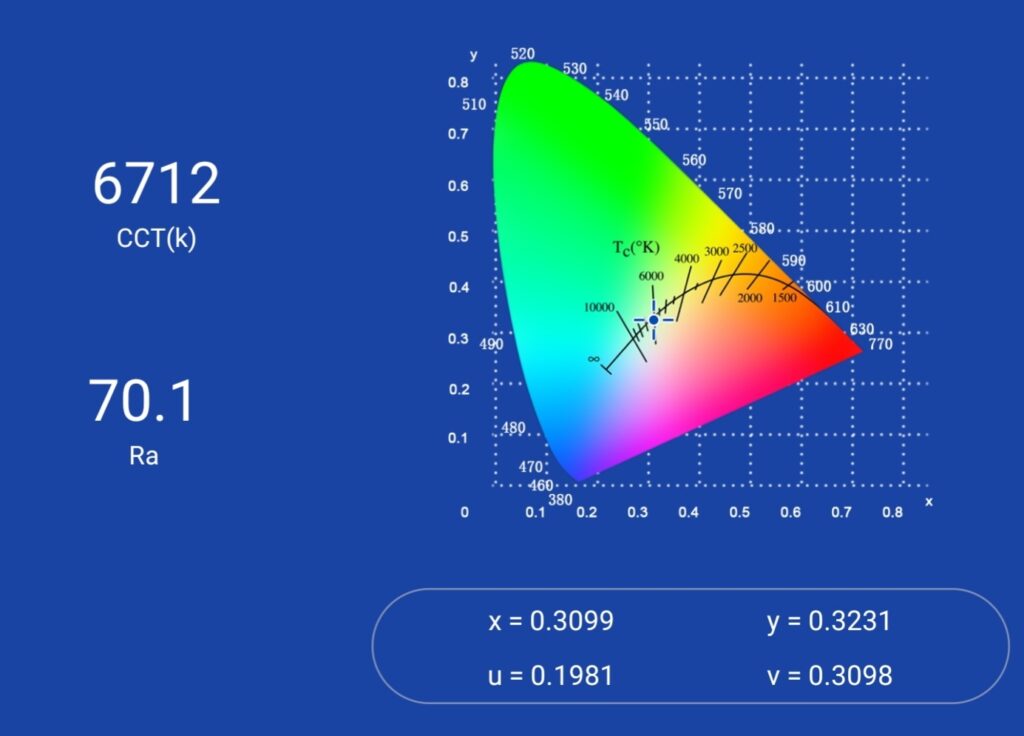
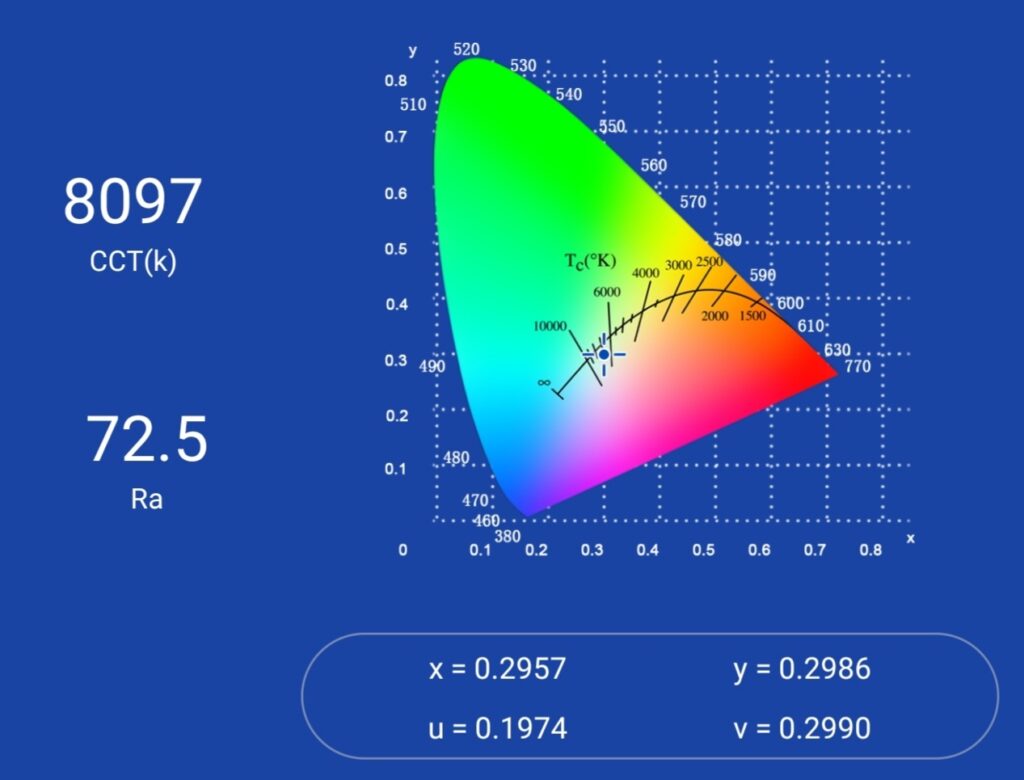
Dimensions and size comparison
Dimensions:
| Dimension | Millimeters | Inches |
|---|---|---|
| Length | 250 | 9.84 |
| Head diameter | 65 mm | 2.55 |
| Body diameter | 27.7 mm | 1.12 |
Weight:
| Weight | Grams | Oz. |
|---|---|---|
| Without battery: | 375 | 13.3 |
| With battery | 511 | 18 |
Flashlight size comparison with its competition
I compared the PK21 with some other long flashlights.
Group 1 left to right: Nitecore MH04S, Lumintop PK21, Wurkkos DL70, Nightwatch NS59V1
Group 2 left to right (long range flashlights): Convoy L21B, Lumintop PK21, Speras E3R
Group 3 top to bottom: Amutorch XT60 NB90.16, Lumintop PK21, Nightwatch NI03 Valkyrie, Thorfire C8, Emisar D1 2022.
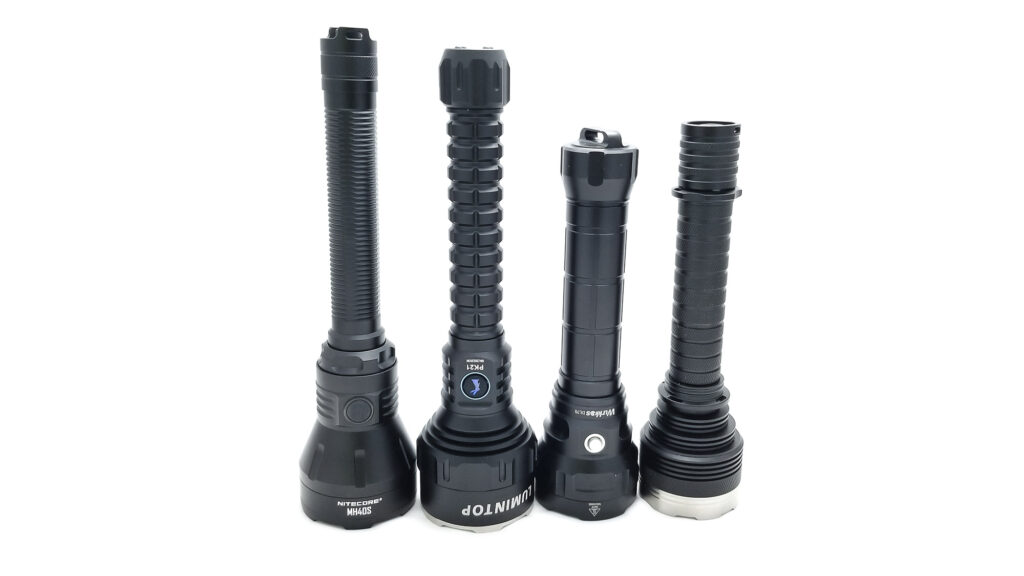
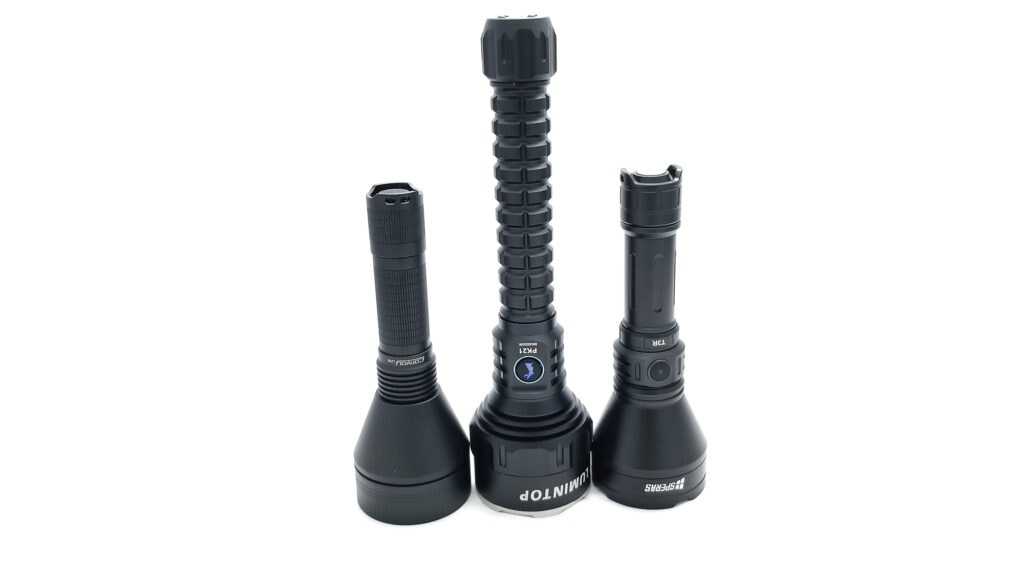
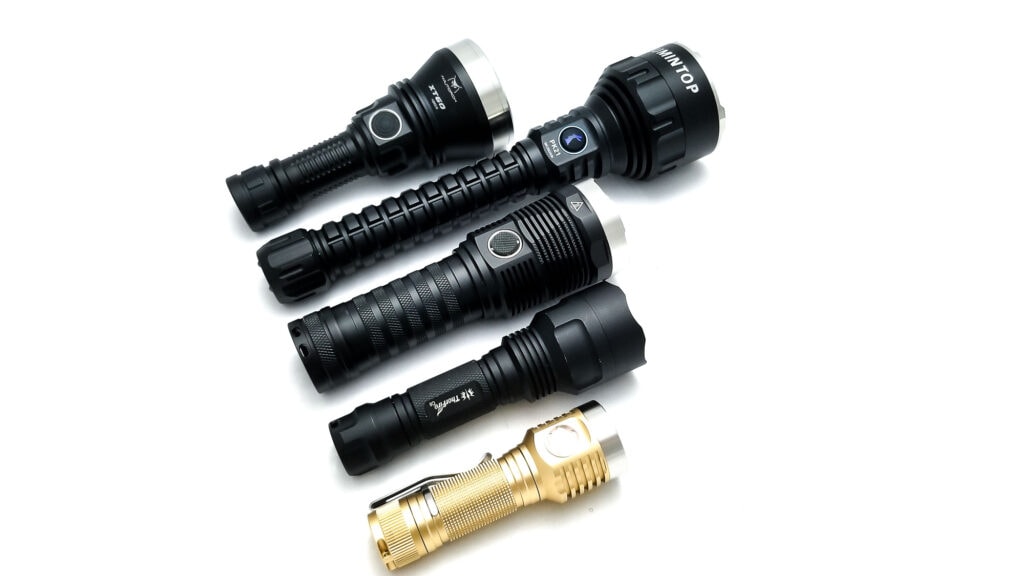
Driver & User Interface:
Since we have 2 series cells, the PK21 is probably sporting a buck driver or a linear FET driver. I can’t say for sure, but the runtimes will tell all!
The PK21 follows other Lumintop lights and features Anduril for the UI. Although I’d like to have seen Anduril 2 on a new light like this in late 2022, Anduril is still a highly advanced and configurable UI.
The firmware used in this light is known as Anduril:
Check out the full Anduril UI manual here.
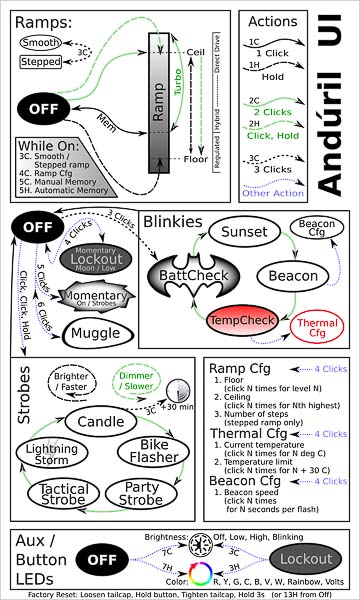
From OFF:
- Single-click: ON
- Double click: High
- 3 clicks: Battery check
- 4 clicks: Lock Out
- 5 clicks: Momentary On
- 6 clicks: Muggle mode
- 7 clicks: Aux configuration mode
Enter Special/Fun modes from OFF:
- 2 clicks + hold: Strobe modes (Click, Click, Click and hold)
- 4 clicks: Lock Out mode (momentary on: dim)
- 5 clicks: momentary mode (Bright) ( you can only deactivate by breaking electrical contact between the batteries and the driver by unscrewing the body from the head.
- 6 clicks: Muggle mode
From ON:
- Single-click: Off
- Double click: Turbo
- 3 clicks: change ramping mode. Instead of a smooth increase, it has 6 little steps between Low and Max.
- 4 clicks: ramping configuration mode (Problematic if you make some changes here by accident)
- Press and hold: brightness ramps up.. release and press and hold again to ramp down.
SPECIAL AND FUN MODES:
Read the full manual on how to access and customize these modes. Also, see the firmware picture.
- Blinky Utility mode:
- Battery check
- Sunset Mode
- Beacon mode
- Temperature check
- Strobe / Mood modes:
- Candle
- Bike flasher
- Party strobe
- Tactical Strobe
- Lightning mode
- Lockout mode (can’t use the light) (activate by 4 clicks)
- Momentary mode (signaling/morse coding)
- Muggle mode: (safer for children)
- Configuration mode
- Ramp config mode
LOCK OUT FEATURE:
- From OFF: 4 clicks. To deactivate click another 4 times.
PWM
- Yes. Anduril has fast PWM not visible to the naked eye.
Additional info on the UI:
- Anduril is one of the most advanced UIs out there, only usurped by Anduril 2. Still, it’s a complex UI, so while it may do everything but make you a sandwich, it can be a bit intimidating to learn. Once mastered though, it’s very useful, and on an enthusiast light, being able to tweak the thermal limits is really important since it can make a big difference on the usability of the light. Lo and behold, the thermal configuration for the PK21 was spot on, but the ceiling was set to 50 C, which in this light doesn’t afford much time in the higher modes, but will keep your hands and fingers happy.
Batteries & Charging
The PK21 is a dual 21700 battery configuration, so 8.4 volts fully charged and 7.4 volts nominal. According to Lumintop, you’re limited to button top, unprotected batteries (with a caveat). The sample light came with two Samsung 30T 3000 mAh high discharge batteries, and they appear to be real since my VapCell S4+ shows the internal resistance at around 10 to 15 milliohms. The other conundrum is these flat tops actually worked in the light, when my other 30Ts did not.
Odd. I tried some Molicel P42As and some Samsung 50G button tops and they both worked fine. You will get the highest output from the 30Ts though. There is no integrated charging on this light, and that’s fine with me since series charging gets complicated without resorting to a proprietary battery or battery pack. The downside is you will need a suitable li-ion charger, so if you don’t have one, you’ll have to pony up for it.
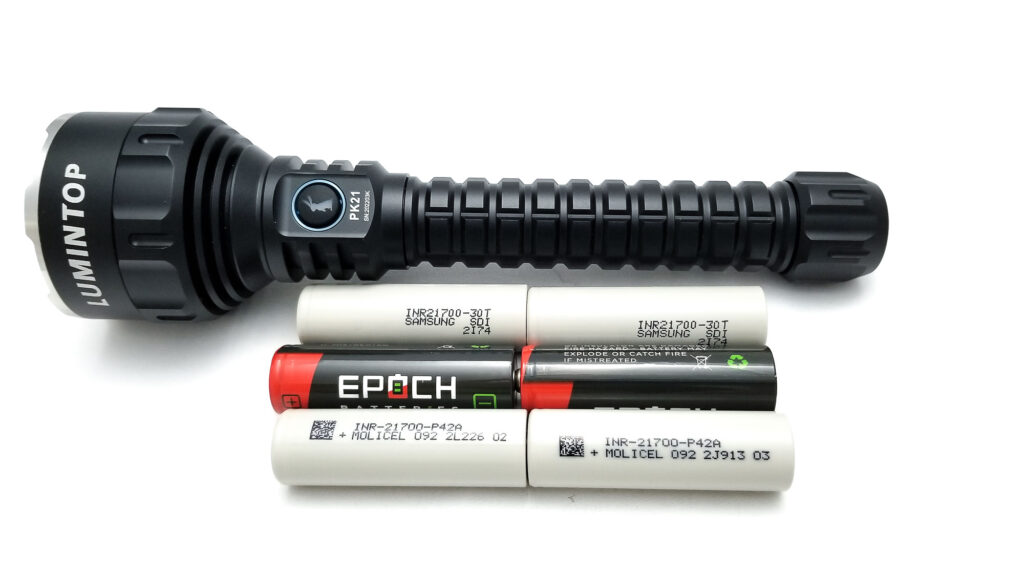
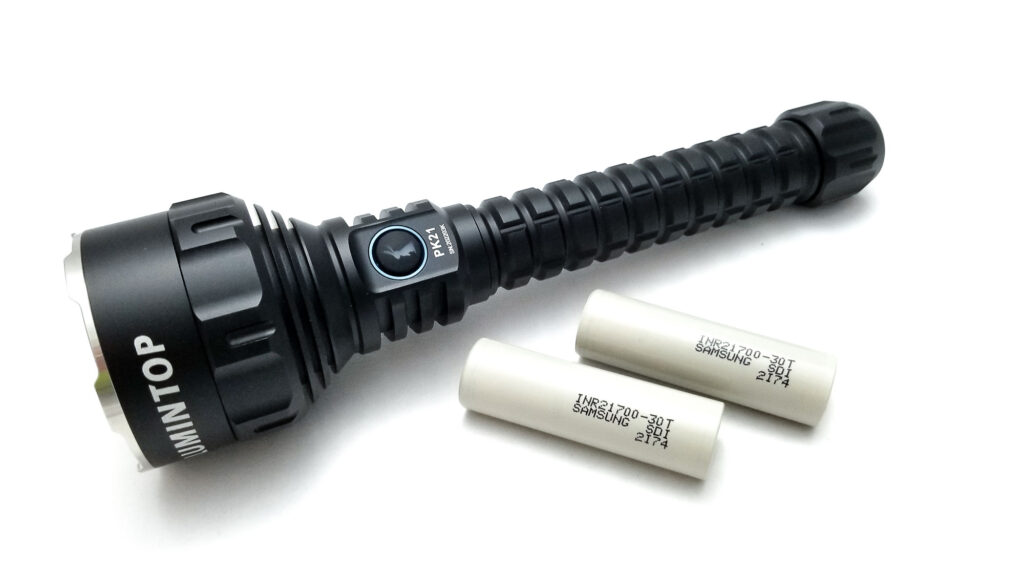
Performance test
Lumen measurements
I measure Lumens using my home made 50 cm integrating sphere and a Digi-Sense 20250-00 datalogging luxmeter. It’s been calibrated with many lights and is within 10% of actual output. Amps are measured with my Thsinde B18+ multimeter for lower current, and my FY219 clamp meter for higher current over 3 amps. I used the two included, fully charged Samsung 30T 21700s. I used the stepped ramping for the modes. Lumintop advertises 8100 Lumens for this light which is a bit optimistic. Let’s see though…
| Mode | Amps at start | Specs | turn on | 30 sec | 10 minutes |
|---|---|---|---|---|---|
| L1 | 2.25 mA | ? | N/A | N/A | – |
| L2 | 19.78 mA | ? | 14 lm | 14 lm | – |
| L3 | 76 mA | ? | 69 lm | 69 lm | – |
| L4 | 380 mA | ? | 318 lm | 319 lm | – |
| L5 | 2.95 A | ? | 1755 lm | 1755 lm | – |
| L6 | 7.95 A | ? | 3864 lm | 2646 lm | 420 lm |
| L7 | 17 A | ? | 6580 lm | 1540 lm | 700 lm |
| Turbo | 25.4 A | 8100 | 8246 lm | 399 lm | 665 lm |
Color me impressed! I beat Lumintop’s advertised figure, which is pretty incredible for the XHP70.2 with a dome, and even more so with a dedomed emitter. The improvements in thermal resistance have netted some nice performance gains. However, like all high power Anduril lights, the 30-second output is dismal. Turbo is 399. Those are at the Anduril default 50 C. When I maxed the thermal ceiling to 70 C for Turbo, it’s a different story: At 30 seconds the output is 4655 Lumens, and at 10 minutes it’s 1463 Lumens. However, a word of caution, since your hands will not be happy though since by 10 minutes it is too hot to hold, even by the rearmost part of the tube.
Parasitic drain:
- 1.07mA
Lumintop PK21 Battery Life: Runtime graphs
Runtimes were tested using the 50 cm integrating sphere and Digi-Sense 20250-00 datalogging luxmeter. I measure temperatures with my Ames non-contact thermometer. I used the fully charged Samsung 30Ts that came with the light for the tests. I tested levels 6, 7, and Turbo.
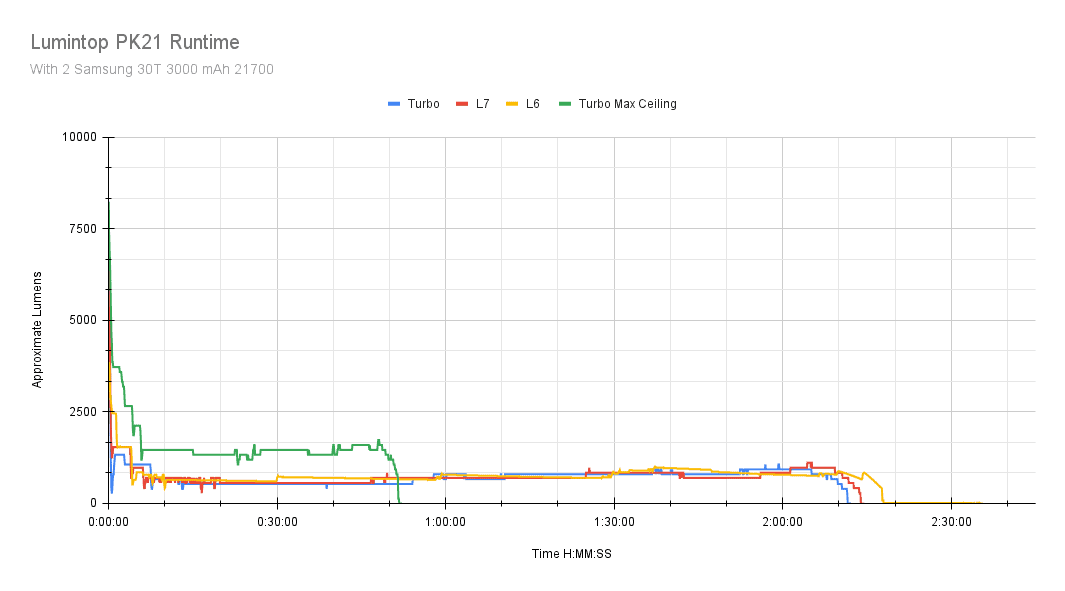

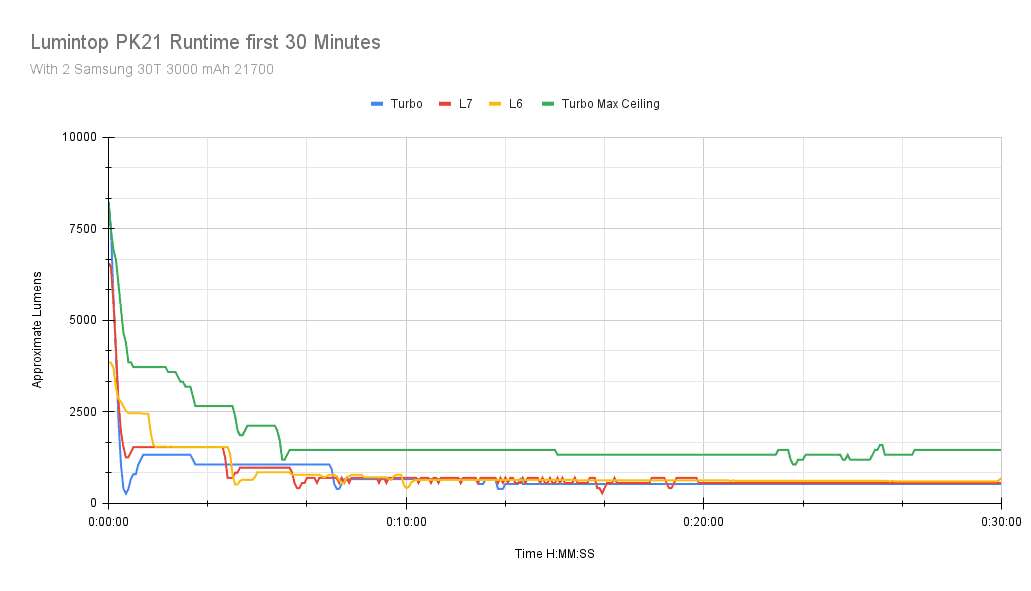
| Mode | Specified | Measured runtime (ANSI) | Time till shut off |
|---|---|---|---|
| L6 | ? | 2h 17m | 2h 35m+ |
| L7 | ? | 2h 11m | 2h 13m+ |
| Turbo* | ? | 30 seconds | 2h 11m+ |
The extra output when the thermal limit was maxed takes a toll on runtime. With the thermal ceiling maxed out, Turbo lasted just 51 minutes. The Turbo mode drops to 399 Lumens within 30 seconds on the default setting! In typical Anduril fashion, the output drops very low when LVP hits, so I end the test there. After each test, the battery closest to the driver held a higher termination voltage than the rearmost cell, which was discharged to 2.7 to 2.75 volts versus 2.89 volts. This tells me the driver is set to pull the plug at around 5.6 volts.
ANSI FL1 standards: The runtime is measured until the light drops to 10% of its initial output (30 seconds after turning on). This does not mean that the flashlight is not usable anymore. The last column shows how long the light actually works till it shuts off. If there is a + symbol, it means that the test was stopped at that particular point, but the light was actually still running. This happens on certain occasions, with certain drivers, firmware, or batteries.
Peak beam intensity and beam distance measurements
Beam distance measurements were taken outdoors at 10 meters using the Uni-T UT383S luxmeter. I used the included, fully charged Samsung 30Ts, and allowed the light to cool down before testing L6, L7, and Turbo.
| Mode | Specs | Candela measured | Meters | Yards |
|---|---|---|---|---|
| L1 | ? | N/A | N/A | N/A |
| L2 | ? | 500 | 44.7 | 48.8 |
| L3 | ? | 2900 | 108 | 118 |
| L4 | ? | 14,200 | 238 | 261 |
| L5 | ? | 78,800 | 561 | 614 |
| L6 | ? | 181,600 | 852 | 932 |
| L7 | ? | 325,000 | 1140 | 1247 |
| Turbo | 1200 meters | 96,400 cd (423,300 at start) | 621 m (1301 at start) | 679 (1423 at start) |
L1 was too dim at 10 meters. Surprisingly, I beat Lumintop’s throw spec at turn-on, but after 30 seconds, the output is already dropping rapidly and at 30 seconds, the figure is only about 620 meters of throw. A higher thermal ceiling would have helped here substantially. .
Extra info: Peak beam distance according to ANSI FL1 standards: The calculated value of distance in meters at which the flashlight produces a light intensity of 0.25 lux. (0.25 lux is about the brightness of a full moon shining on an object).
Beamshots
Photos taken with my Samsung Note 8. The short range photos were taken with the camera set to 0.3s ISO 200 with 5000K WB. The long-range photos used 0.5s ISO 400 and 5000K WB. The fence is 95 meters away.
Beamshots compared to the following flashlights:
- Sofirn SP36 Pro Anduril 2
- Nightwatch NI03 Valkyrie
- Amutorch XT60 NB90.16
- Astrolux FT02S
- Astrolux MF01 Mini
- Wurkkos DL70 (2×26650)
- Imalent R30C
- Wuben A1 (long range)








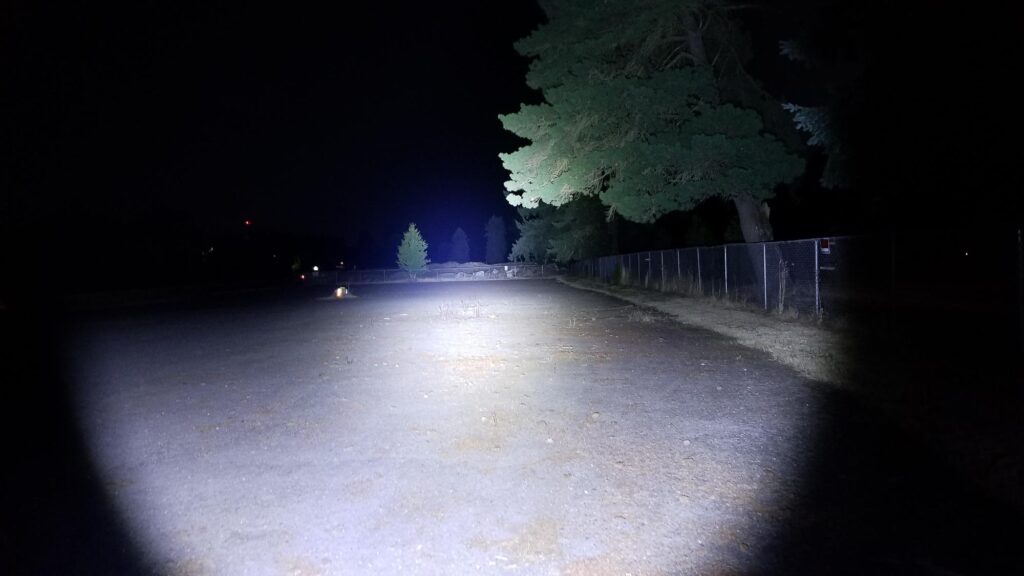
The water tower is about 950 meters away.


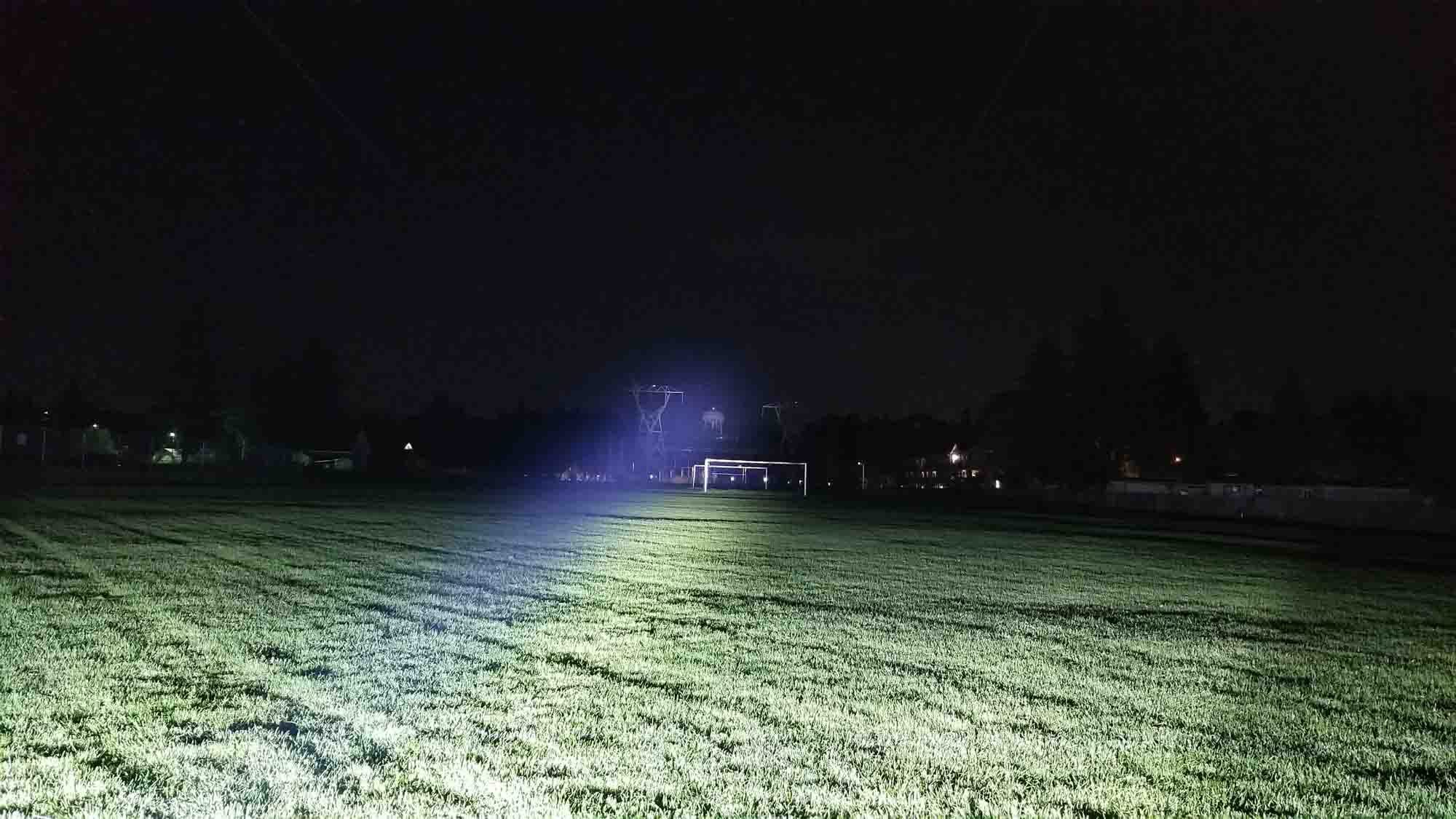


Disclaimer: This flashlight was sent to me for review at no cost by Nealsgadgets. I have not been paid to review, nor have I been holding back on problems or defects.
Final Verdict
Pros
- Crazy bright for a single LED
- Awesome build quality
- Glass breaker in tailcap
- Anduril UI
- Great beam distance
- No Cree XHP tint shift
- Excellent beam distance
Cons
- No onboard charging
- Doesn’t include a lanyard attachment
- FAST step down on Turbo (default settings)
Explanation on star ratings:
1: Avoid: a match would be a better choice – 2: Poor: significant defect or issues; almost unusable – 3: Average: some defects or issues; but still usable 4: Good: recommended (minor issues) – 5: Great: highly recommended

4.5 stars: ★★★★★⋆
One thing I’ve learned over the years is it’s okay to be wrong. In fact, I don’t mind eating my words as long as they taste good, and the Lumintop PK21 is one such example. Some flashlight companies are notorious for overinflating and puffing up specs, and I fully expected that. Wrong! The PK21 really does make 8100 Lumens (actually a bit more) and meets the beam distance spec.
For a single LED that’s not a SFH55, that’s pretty incredible. These performance numbers are usually seen on crazy overdriven XHP70.2s. Overall, the PK21 is a super-solid light. It’s punching above its weight class, and combines tons of throw and tons of output. I love the handling characteristics, balance, and the build quality is amazing (like my other Lumintop). The beam from that XHP70.3 is very nice, uniform, and mostly devoid of the ugly tint shift of the gen 2 XHPs. It also throws great. 1200+ meters from a barely 65mm head and 8000+ lumens? I really hope to see this LED being swapped into existing XHP70.2 lights soon!
I can’t complain about this light much save for the lack of onboard charging (I get it, series batteries complicates that), no lanyard mounting point (at least Lumintop could have included a screw-in attachment point), and the obligatory uber-fast step down on Turbo. Anduril is both a perpetual blessing and curse, but that’s what user guides are for. No word on street prices yet for this, but if Lumintop can keep it under $120, this thing’s a winner. It positively blows the L7 and Sofirn SP70 out of the solar system, and there really isn’t any competition for this light as of now. Stand tall Lumintop PK21, you get 4.5 stars.
Lumintop PK21 For Sale
Use our unique coupon code at Nealsgadgets: 1LumenNew or 1Lumen711
1lumen selects and reviews products personally. We may earn affiliate commissions through our links, which help support our testing.